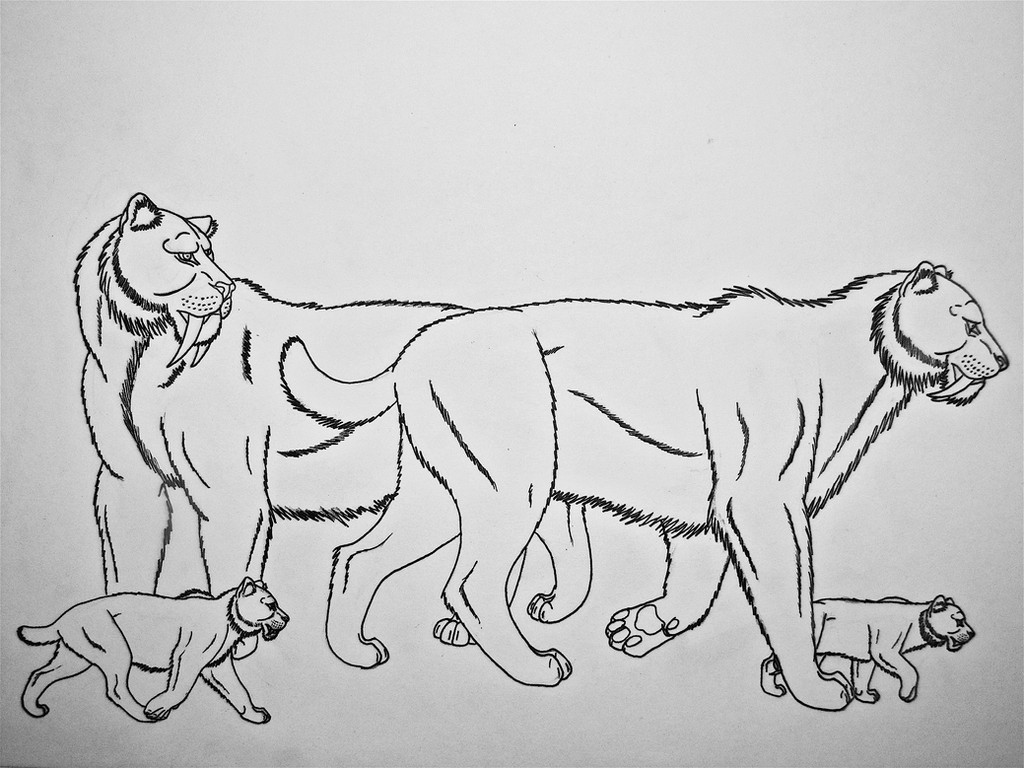HOME | DD
 Saberrex — Smilodon- The Sabertooth Cat
by-nc-sa
Saberrex — Smilodon- The Sabertooth Cat
by-nc-sa

#smilodon
Published: 2016-04-25 04:12:30 +0000 UTC; Views: 2237; Favourites: 30; Downloads: 12
Redirect to original
Description
“What did this? I’ll tell you what gave me these scars. A Sabertooth cat; hell on legs. I’m lucky I didn’t lose more than just my arm.” –Uri Bakk-Er, nomad trader and sabertooth cat victim.
If there is one member of the big cat family that people automatically fear, then it is the Sabertooth cat, Smilodon giganteus. A huge animal weighing 1,000 pounds in the largest males and measuring 4.5 feet at the shoulder, Smilodon is armed with 12-inch upper canine fangs for quick, efficient kills. In appearance, it is brown with darker spot rosettes and blotches, with a tiger-like ruff of fur around its face.
A pack-hunter, it lives in groups like lions, but the group, like with wolves, is centered around an alpha pair. Unlike wolf packs, all the adult individuals within the pack breed; males, usually a single male, coalition or siblings, pair for life with any unmated females within an already existing group (or form their own). Just as with lions, mothers share parental duties, and will care for each other’s cubs, readily adopting their siblings’ cubs if their mothers die. But as adult Smilodon care for each other if one pack-mate is injured, the survival rate for pack members is greater than is in lions. Unlike with lions, there is little to no competition for females between males except when they fully mature, as they rarely remain unmated long after. Smilodon cubs meanwhile are unique among cats; they are born with a full set of teeth. However, their “milk-sabers” are serrated for cutting flesh. Once weaned off of milk, this allows the young smilodon to easily feed at the carcass alongside their parents. Only upon reaching reach a-year-and-a-half old do the cubs start developing their infamous teeth, and it takes another year-and-a-half to let them grow to full size.
In their hunting capabilities, Smilodon are unrivaled among the big cats. They are deceivingly quiet when hunting, and are superb ambush hunters that fear nothing. Smilodon also have astounding endurance; despite their slower speed compared to lions, they can keep up a chase for hours before finally catching and killing their prey. Focusing on large game weighing from 500 pounds up to 6 tons, they attack by wrestling their prey to the ground before biting into the neck to sever the arteries and windpipe. A bite to the throat can kill an animal in less than a minute. Hunting in groups furthers the success rate, allowing the cats to kill very large animals without breaking their teeth. The diet of Smilodon consists of large mammals and dinosaurs, and they most frequently hunt buffalo, horses, wild pigs, Fell deer, camels, and even such animals as rhinoceros and hadrosaurs weighing up to 6 tons. Smilodon rarely attacks humans, as they are normally too bony to risk attacking without potentially breaking their teeth, but older, sick or severely injured individuals are known for becoming man-eaters. It is for this reason most people are terrified by Smilodon.
For all their terrifying abilities, Smilodon are highly intelligent; enough to understand human speech. For this reason, they tend to avoid making trouble with humans and other sentient species. This has allowed them to live in relative peace with humanoids, and occasionally, they become pets for those who embrace nature as a part of their lives. However, the sight of a Smilodon, even a tame one, is enough to cause gasps of fear among those uninitiated to their presence.
A Smilodon family, done with almost no references. One of my favorite big cat sketches thus far.
Related content
Comments: 19

There are three species of Smilodon: S. Gracilis, S. Fatalis and S. Populator.
👍: 0 ⏩: 1

This was for a book I am currently writing. Hence I did not mention any species in the genus.
👍: 0 ⏩: 1

You might want to read the description then. It explains quite a bit.
👍: 0 ⏩: 0

yup. If humans hadn't driven it extinct, it would still be around today.
👍: 0 ⏩: 1

Do you seriously believe in Blitzkrieg?
👍: 0 ⏩: 1

well, I should say extinct through competition.
👍: 0 ⏩: 1

The timing still doesn't sync.
👍: 0 ⏩: 1

how so? clovis people were around to hunt those animals that Smilodon also hunted.
👍: 0 ⏩: 1

In Australia, the gap between man setting foot on Australia and the extinction of Australia's megafauna was 13,000 years. Too long.
Man left Africa and set foot in Eurasia more or less than 50,000 years ago, yet the extinction of Eurasia's megafauna happened 10,000 years ago. Too long.
The oldest discovered American, "Eve", was discovered in a cave in Mexico's Yucatan Peninsula and dated to be 13,500 years old, 500 years older than the supposed time that man crossed Beringia. This could imply that man crossed Beringia at a far earlier date, yet the dating of the extinction of America's megafauna coincided with that in Eurasia. Too long.
There's also into consideration the Younger Dryas climate chaos phenomenon, which did coincide with the extinction of the 30 genera of Pleistocene megafauna, a handful of microfauna and plants, not to mention the Clovis culture itself.
If man was the cause of the extinction event, the gap between man setting foot in new lands and the megafaunal extinction would've been a few generations, not a few millennia.
👍: 0 ⏩: 0

Interestingly enough I also made a fictional descendant of Smilodon. Dubbed Smilodon Maximus, as big as the biggest grizzly bears and worshipped as gods by Mesoamericans, one of them being the mythical city of El Dorado.
👍: 0 ⏩: 1


























